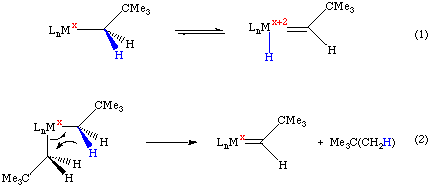
Alpha-hydride elimination is the transfer of a hydride (hydrogen atom) from the alpha-position on a ligand to the metal center. The process can be thought of as a type of oxidative addition reaction as the metal center is oxidized by two electrons (Eq 1).
As the reaction involves a formal oxidation of the metal, alpha-elimination can not occur in a d0 or d1 metal complex. In these cases, a variant called alpha-abstraction can occur. Alpha-abstraction does not result in a change of oxidation state and the alpha-hydrogen is transferred directly to an adjacent ligand instead of the metal center (Eq 2):

Alpha-abstraction is a common method for synthesizing high oxidation state alkylidene and alkylidyne complexes. While alpha-elimination requires an open coordination site on the metal complex, alpha-abstraction does not. As shown below, alpha-abstraction may be induced by a steric crowding of the metal; the abstraction can occur spontaneously or be induced by addition of a donor ligand such as a phosphine:

The mechanism of both alpha-elimination and alpha-abstraction proceeds through the same sort of four-center transition state as beta-hydride elimination or sigma bond metathesis. Alpha elimination/abstraction can occur when the metal contains both alpha and beta hydrogens, but is most common when beta-hydride elimination is blocked.
The microscopic reverse of a alpha-hydride abstraction would be a called a carbon-hydrogen bond activation in which the C-H bond adds across a metal-ligand bond. In practice, such activations are rare, although highly desirable from the context of functionalization of hydrocarbons.
A third type of elimination reaction encountered with alkyl ligands is the delta elimination reaction.